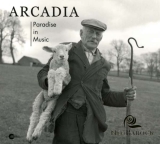 NeoBarock - Arcadia Paradise in Music; Anonymus: Contrapunct sopra la Baßigaylos d'Altr. + Pastorale;, Heinrich Ignaz Franz Biber: Pastorella; Alessandro Scarlatti: Arpeggio & Pastorale; Domenico Scarlatti: Sonate K. 513; Johann Heinrich Schmelzer: Pastorella + La bella Pastora; Signor C.: Pastorale del Signor C.; Giuseppe Tartini: Pastorale op. 1; NeoBarock (Maren Ries, Volker Möller, Violine, Ariane Spiegel, Cello, Stanislav Gres, Cembalo); 1 CD Ambitus amb 96842; Aufnahme 07/2020, Veröffentlichung 01.2022 (64'56) – Rezension von Uwe Krusch
NeoBarock - Arcadia Paradise in Music; Anonymus: Contrapunct sopra la Baßigaylos d'Altr. + Pastorale;, Heinrich Ignaz Franz Biber: Pastorella; Alessandro Scarlatti: Arpeggio & Pastorale; Domenico Scarlatti: Sonate K. 513; Johann Heinrich Schmelzer: Pastorella + La bella Pastora; Signor C.: Pastorale del Signor C.; Giuseppe Tartini: Pastorale op. 1; NeoBarock (Maren Ries, Volker Möller, Violine, Ariane Spiegel, Cello, Stanislav Gres, Cembalo); 1 CD Ambitus amb 96842; Aufnahme 07/2020, Veröffentlichung 01.2022 (64'56) – Rezension von Uwe Krusch
Seit Theokrit und Virgil, erneuert von Jacopo Sannazaro mit seinem Roman Arcadia um 1500, existiert dieses Bild der idyllischen, idealen Landschaften, in denen Schäfer ihre Herden weiden und ihre pastorale Musik spielen. Vorwiegend derartige Musik hat diese CD versammelt, um ein musikalisch paradiesisches Bild dieser Idee zu zeichnen.
Das Ensemble NeoBarock mit zwei Violinen, Cello und Cembalo hat eine Reihe von Pastoralen eingespielt, die allein schon mit ihrer rhythmischen Komponente eine Verbindung erzielen. Vorwiegend bekannte Namen von Biber bis Tartini finden sich da neben anonymen Werken und Senior C.
Mit Hingabe widmen sich die Musiker von NeoBarock der Darstellung dieses Ideals. Man bekommt aber auch den Eindruck, als hätten sie nicht vergessen, dass in der Landwirtschaft, und ein Schäfer mit seinen Herden gehört gewiss dazu, auch kraftvoll und fest zugepackt wird. Und so werden manche Passagen durchaus auch markig angegangen. Zur Auflockerung sind kleine Cembalo-Intermezzi mit von der Landpartie und sorgen für andere Töne.
Since Theocritus and Virgil, renewed by Jacopo Sannazaro with his novel Arcadia around 1500, exists the image of idyllic, ideal landscapes where shepherds graze their flocks and play their pastoral music. It is mainly music of this kind that this CD has gathered together to paint a musically paradisiacal picture of this idea.
The ensemble NeoBarock with two violins, cello and harpsichord has recorded a series of Pastorales that achieve a connection with their rhythmic component alone. Predominantly well-known names from Biber to Tartini can be found there alongside anonymous works and one by Senior C.
With devotion the musicians of NeoBarock dedicate themselves to the representation of this ideal. But one also gets the impression that they have not forgotten that in agriculture, and a shepherd with his flocks certainly belongs to it, one also grabs powerfully and firmly. And so some passages are tackled quite pithily. To loosen up, small harpsichord intermezzi are part of the country trip and provide other tones.
























